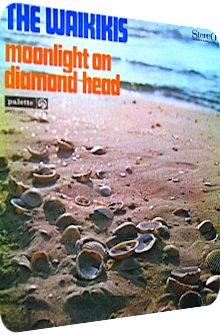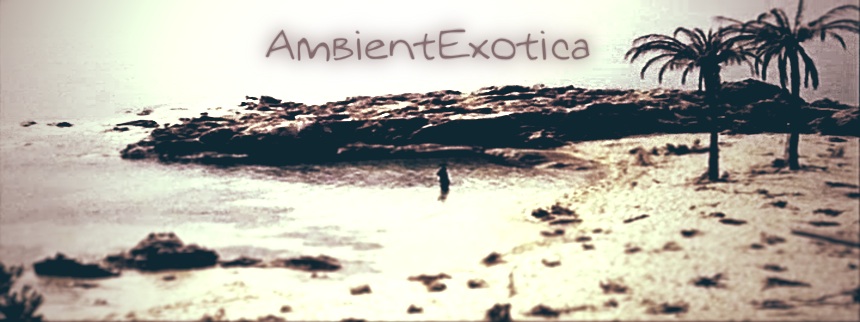
The Waikikis
Moonlight On
Diamond Head
1969
Moonlight On Diamond Head is an all too late but exquisitely alluvial twelve-track Hapa Haole LP by the Belgian combo The Waikikis, released in 1969 on the Dutch Palette label, cross-licensed to Kapp Records and featuring ten Hawaiian classics and two unique compositions. It is one of those magical albums which – in an alternative reality or another dimension – could have enchanted many an Exotica aficionado, for The Waikikis are clearly not interested in delivering their material in a bog-standard way. While their albums are indeed based on steel guitar twangs, these are only the base frame for a cavalcade of organs, bongos, flutes, accordions, leaving even enough room for humming choirs to shine. Moonlight On Diamond Head gets rid of the hyperbolic hyper frenzy that is their debut Hawaii Tattoo (1964) in favor of a wonderfully dreamy and occasionally uptempo-driven aura.
Diamond Head is situated on the island of Oahu and the name of a volcanic cone, otherwise known to Hawaiians as Leahi, the latter of which incidentally serves as the inspiration for Milt Raskin's fabulous Kapu (1959). The setting is wisely chosen and well transformed into music most of the time. Frank Pleyer and Heinz von Alten reprise their roles as the band’s supervisors (akin to the roles of Don Tiki’s Kit Ebersbach and Lloyd Kandell), with Jo van Wetter on the steel guitar, Jo De Muynck and Freddy Rottier on the percussion, William “Willy” Albimoor on the clarinet as well as Jean Hunstadt on the bass reprising their respective roles. Some of the artists change their instruments on the fly in order to drop acoustic guitar notes, organ shards and flute tones throughout the work. Here is a closer look at all 12 tracks. Be prepared for an unexpected flash of genius or two, defying the album’s long-forgotten luminosity.
Less considered and hence a good start for an album: a take on Gordon Jenkins’ Moonlight On Diamond Head. It is definitely not the blandest of all incarnations, for its alto flute spirals and Jo van Wetter’s steel guitar chords gleam in the darkness, with the short marimba blebs and car-horn organs ameliorating the Hapa Haole minimalism further, until it reaches the state of a sun-dappled moon anthem. Alex Kramer’s and Joan Whitney’s Far-Away Places sees its languorous tone sequences slowed down into a maraca-accentuated complaisance-oriented mélange of a humming choir with sparkling glockenspiels and van Wetter’s yellowed ashen steel guitars next to an acoustic shrubbery. This incarnation is by no means a must-have Exotica piece, but its obscure darkness and insouciance are wonderfully ephemeral fugacities of joy.
While R. Alex Anderson’s classic Lovely Hula Hands features the typical Hawaiian warped steel twangs next to an enchanting mixture of polka dot flute-xylophone couples, distantly twirling organ helixes and a bongo-accentuated groove which altogether make this a genuinely decent interpretation, Jo van Wetter’s own Coconut Shells boosts the hillbilly flavor with a wonky steel guitar Effulgence, breakneck tempos, mountainous progressions of that car horn organ and hefty tambourine-accentuated drums complete with mercurial flute sections.
Michel Mauleart Monton‘s Yellow Bird, already an almost a long-forgotten piece in 1969, is gorgeously brought to life by a soothingly exotic bongo aorta, chirping flutes, organ washes in tandem with steel guitar prowess as well as an overall carefreeness and placidity. The lacunar-fissured structure and the downtempo physiognomy interpolate the dreaminess. Add quasi-Mexican xylophone driblets to the scenery, and you got yourself the second hit on side A which incidentally closes with a dreamy take on Richard Rodgers’ and Oscar Hammerstein II’s Bali Ha’i. This version reduces the organ tomfoolery in favor of paradisiac steel guitar glints and an overall phantasmagoric interplay of flute, xylophone and steel guitar textures.
Side B opens in a gorgeous fashion, truthfully nocturnal and semi-creepy, at least in its prelude phase: Arthur Freed’s and Nacio Herb Brown’s Pagan Love Song launches with cautiously beaten bongos, glissando swells of Gothic organ moirés and a superbly portentous oboe melody before the tune gives in to Hawaiiana. Delicately arranged and reverberated steel guitar globs, organ washes and accordion flecks swirl through the soothingly igneous place. The flute melody in the middle is pristine and pure. Another unexpected gem of a rendition! Dorothy Stewart’s Now Is The Hour is a let-down in this regard, for it is a clichéd hammock midday take on a potentially moonlit scene. The flute tones and acoustic guitars are great, as is the laid-back maraca shrubbery with guiro branches, but van Wetter’s steel guitar is too dazzling for my taste. Benny Sax’s Hula Eyes is envisioned much better and opens the instrumental pool another time by placing a wonderfully lounge-like bachelor pad piano shrapnel in adjacency to the bongo blebs and flute/steel guitar concoction. This marks the second instance where the choir hums along. In all honesty, this is hands down a great piece of, er, Ambient Exotica!
Whereas Jo van Wetter's own Hawaiian Punch is severely twisted and unchains the expected hyper-frantic erethism or boozorama with a focus on the organs next to the steel guitar arabesques, The Moon of Manakoora by Alfred Newman and Frank Loesser is another instrumentation that lives up to the moonlit beauty of the original. The steel guitar chords can fade into the distance, their afterglow is ashen, and I forward bonus points to the band for including the raspy guiro base frame and the bubbling xylophone placenta. Queen Lydia Lili’uokalani’s Aloha Oe ends the album in an uplifting manner, with a final encore of the humming hula choir and a crazy Space-Age performance on the organ which wobbles along in tandem with the steel guitar and falsetto flutes. I usually despise most versions of Aloha Oe out there, for its impact, ubiquity and constant airplay made it suffer, but this version I can agree with. An enjoyable fade-out.
A bittersweet remark: Moonlight On Diamon Head does not even reach 50% of the downright crazy space escapades of the band’s debut Hawaii Tattoo which remains a Space-Age artifact that is – cleverly or not – camouflaged as a Hapa Haole album. Moonlight On Diamond Head features the same ingredients and, probably most importantly so, the same enthusiasm with its older brother, but is much more keen on proper Hawaiian soils. The organs, flutes and occasional one-off appearances of the accordions and pianos at least imply that this is no mere soulless ode to the old times, but a proper entry in the discography of The Waikikis. Two particular things are done remarkably right: first, there is a delightful soothingness and moony aura engraved into most of the tunes, and during these instances, Moonlight On Diamond Head truly shines and could have been somewhat of a classic… were it not for its late release date of 1969 when Exotica was anything more than a faded fad, and the Europe-centric roots of the Belgian band.
Anyway, the interpretations of Moon Of Manakoora, Yellow Bird and Pagan Love Song are top-notch and truly warmhearted without any histrionic protrusion of Space-Age weirdness attached to them. Second, the band manages to keep a coherent stringency throughout the album, without letting it appear all too dull, probably due to the magnanimous amount of instruments and the ornamental features which are usually not connected with Hapa Haole. The flow is just right. Do not expect a jaw-dropper here, but some of the renditions are enchanting, not just skillful deliveries. Moonlight On Diamond Head is unfortunately only available on vinyl and will remain a forgotten jewel.
Exotica Review 313: The Waikikis – Moonlight On Diamond Head (1969). Originally published on Feb. 8, 2014 at AmbientExotica.com.
